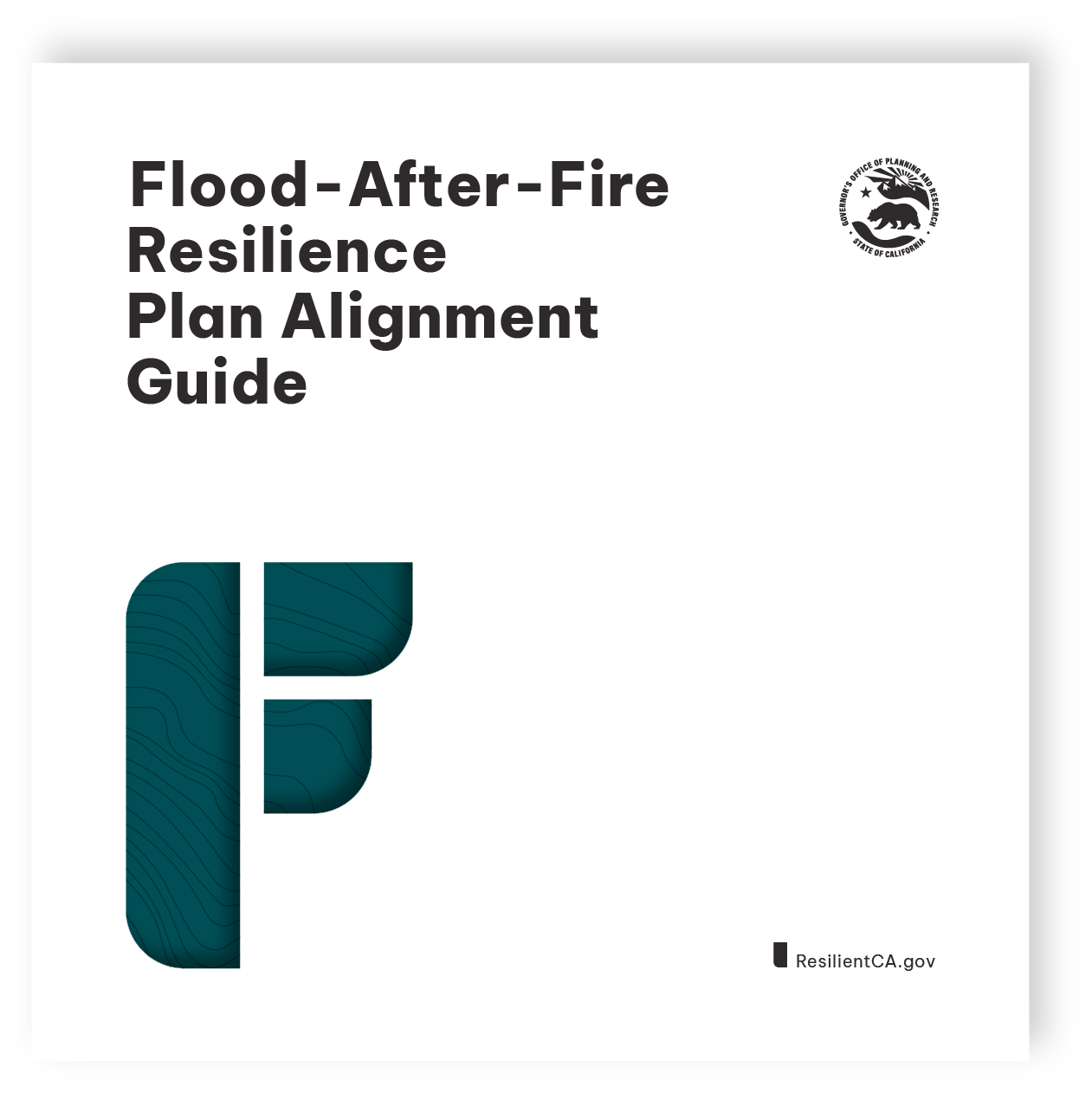Flood-After-Fire Resilience Plan Alignment Guide
Debris flows, landslides, and debris-laden floods are dangerous post-fire hazards. These incidents, also called “flood-after-fire" and “post-fire flood” events, often occur in areas left charred, dry, and less able to absorb water after a fire, and are most likely to occur in hilly and mountainous areas – with the area of a single event ranging from a few square yards to hundreds of acres. Increased risk of flood-after-fire events remain higher than normal until vegetation is restored - up to five years after a wildfire. These events can have devastating impacts on communities, including loss of infrastructure and life, impact the water quality of downstream rivers and streams, and damage habitat.

Aligning Planning for Flood-After-Fire Resilience
As fires become more severe and the wildfire season expands earlier in the summer and later in autumn and winter due to the impacts of climate change, there is an increased need to establish and align goals, policies, and actions across multiple planning documents to promote greater awareness of post-fire flooding risks, inform future land use and development decisions, and decrease the impacts of flood-after-fire events. These planning efforts should incorporate future climate scenarios to ensure that strategies and efforts build long-term resiliency to shifts in wildfire, drought, and precipitation patterns.
The preparation, implementation, and alignment of local plans to comprehensively address flood-after-fire risk is important in working towards resilience under a changing climate. For additional information on the characteristics of flood-after-fire events in California and state efforts to address wildfire and flood risk, see the State Hazard Mitigation Plan, the California Climate Adaptation Strategy, and the Wildfire and Forest Resilience Action Plan.
The Plans
Sections in "The Plans" describe key information, requirements, guidance, and best practices for the most common plans used for wildfire and climate resilience planning. Each plan has a section that identifies alignment opportunities with other plans. Some plans are required for cities and counties in California, while others are optional but can be useful for driving climate resilience and hazard mitigation goals forward. These plans can also be useful for entities such as tribes, special districts, and others looking to comprehensively plan for present and future climate risks and can open pathways to funding and project opportunities that can serve multiple community needs.
This plan identifies potential risks that may arise from local natural hazards and vulnerabilities, and long-term strategies for protecting people, property, and the environment. Local hazard mitigation plans (LHMPs) are not required by the State or Federal government, but states, tribes, and local jurisdictions must have a Federal Emergency Management Agency (FEMA)-approved hazard mitigation plan to be eligible for certain non-disaster funding, including grant opportunities under FEMA’s Hazard Mitigation Assistance (HMA) program. LHMPs can be conducted as multi-jurisdictional (usually countywide) plans (MJHMPs). MJHMPs must include both countywide and jurisdictional-specific information for each participating jurisdiction within the county, and must be adopted by each of the participating jurisdictions.
View PlanAll cities and counties in California are required by state law to adopt and periodically update a general plan, which sets forth a long-term vision of a community’s future. The format and content of general plans can vary, and while certain topics (“elements”) are mandatory, there is no mandatory structure or maximum number of elements that a general plan can include. Mandatory elements required by law include: land use, circulation, housing, conservation, open space, noise, and safety (Gov. Code, § 65302). Additional elements may also be required; for example, cities and counties that have identified disadvantaged communities are required to address environmental justice in their general plans.
Note: See the General Plan Housing Elements and General Plan Safety Elements sections for information specific to those elements.
View PlanThe goal of the safety element is to reduce the potential short and long-term risk of death, injuries, property damage, and economic and social dislocation resulting from fires, floods, droughts, earthquakes, landslides, climate change, and other hazards. Other locally relevant safety issues, such as airport land use, maritime hazards, emergency response, hazardous materials spills, and crime reduction, may also be included. Some local jurisdictions have chosen to incorporate their hazardous waste management plans into their safety elements.
The safety element directly relates to topics also mandated in the (1) land use, (2) conservation, (3) environmental justice, and (4) open-space elements, as development plans must adequately account for public safety considerations and open space for public health and ecological benefits often incorporate areas of increased hazard risk. The safety element must identify hazards and hazard abatement provisions to guide local decisions related to zoning, subdivisions, and entitlement permits.
View PlanThe general plan housing element implements the declaration of State law that “the availability of housing is a matter of vital statewide importance and the attainment of decent housing and a suitable living environment for all Californians is a priority of the highest order” (Gov. Code, § 65580). Provisions in the housing element are more specific and directive than other elements and contain detailed guidance and reviews. The law requires that the Department of Housing and Community Development (HCD) review the housing element for compliance and that local jurisdictions submit annual progress reports to HCD (Gov. Code, §§ 65585, 65400, subd. (a)(2)(B)). The housing element must be revised and submitted periodically on a four, five, or eight year cycle, depending on various factors (Gov. Code, § 65588).
View PlanClimate adaptation plans involve an evaluation and prioritization of actions or strategies to prepare for and respond to climate impacts. The State and Federal government do not require standalone adaptation plans, but cities and counties in California must address climate adaptation in local general plan safety elements per SB 379 (2015) ((Gov. Code, § 65302, subd. (g)(4)). While not required for other jurisdiction types such special districts, climate adaptation planning is encouraged for all communities to prepare for climate change risks, whether the result is an update to one or more existing plans, and/or a new unique plan. Some local or tribal jurisdictions may find it helpful or necessary to consolidate all climate adaptation-related information in a standalone document to be referenced and integrated with other local plans. Standalone plans can also allow for greater detail than other plans. Cities and counties should carefully review related statutory requirements when initiating an adaptation planning process.
View PlanThis framework/plan allows communities to determine their vision for recovery, identify obstacles and opportunities, map out funding sources, and measure their progress. A Disaster Recovery Framework (Framework) defines the local recovery organizational structure and priorities, and helps to identify any capacity gaps where state, federal, or private sector support might be needed. A Disaster Recovery Plan refines priorities outlined in the Framework, provides details for the planning process, and identifies specific recovery activities, projects, funding, and implementation and management plans.
State and federal governments highly encourage local, regional, and tribal agencies to develop a recovery framework and recovery plan pre- or post-disaster, as they can be more flexible to local needs and priorities and integrated into existing planning documents due to the lack of statutory/regulatory requirements.
View PlanImplementing an adaptation framework can take many forms, and the process of integrating climate risk and adaptation solutions throughout government planning, decision-making, and investment processes is iterative and ongoing. The plans described in this Toolkit can support compliance with state adaptation mandates, establish authority for adaptation solutions, open opportunities for funding and financing, and identify specific implementation processes. When developing adaptation strategies in these plans, consider identifying implementation plans, such as the capital improvement plan, specific plans, area plans, or sector-based plans that are useful for implementing the strategies.
View PlanLocal Plans & State Regulations
Visual summary of relationships between common local resilience planning documents in California and key resilience planning regulations.
Note: this graphic reflects both plan relationships reflected in statute, such as relationships between Local Hazard Mitigation Plans and General Plan Safety Elements, as well as plan relationships that are topically relevant, but not legally related, such as relationships between Community Wildfire Protection Plans and General Plan Safety Elements. The Figure does not show all possible connections between plans, and is subject to change as new statutes come into effect.

Example Plan Update Pathways Over 10 Years
A plan alignment best practice is to create an adaptable 5, 10, or 15+ year strategy for updating multiple plans/elements over time and identify ways that portions of different planning processes can be used sequentially to support each other. Consider aligning the update timeline of different plans by adjusting the frequency of subsequent updates. For more tips, see the Best Practices section of this site.
-
LHMP
-
Safety Element/Adaptation
-
Housing Element
-
EJ Element
-
Other General Plan Elements
Sequential Updates
Every 5 or 8 years

Concurrent Updates
Every 5 years

Hybrid Sequential & Concurrent Updates
Every 5 or 8 years

Overlapping Tasks
-
LHMP
-
Safety Element/Adaptation
-
Housing Element
-
EJ Element
-
Other General Plan Elements

Sequential Updates
Voluntary EJ element update, & LHMP update, inform safety & housing element updates.
Concurrent Updates
Housing Element update triggers Safety element update; Concurrent Update of 2 elements triggers EJ element update.
Hybrid Sequential & Concurrent Updates
LHMP update informs safety element update; concurrent update of housing & one or more other general plan elements trigger EJ element update.

Flood-After-Fire Plan Alignment: Sonoma County
Learn about Sonoma County's proactive, integrated planning and adaptive management approach to wildfires and post-fire flood events.
View ResourceFeeling Stuck?
Learn more about the types of resources and information in the Toolkit and find answers to frequently asked questions.
About the Toolkit

